Tour of our permanent exhibition
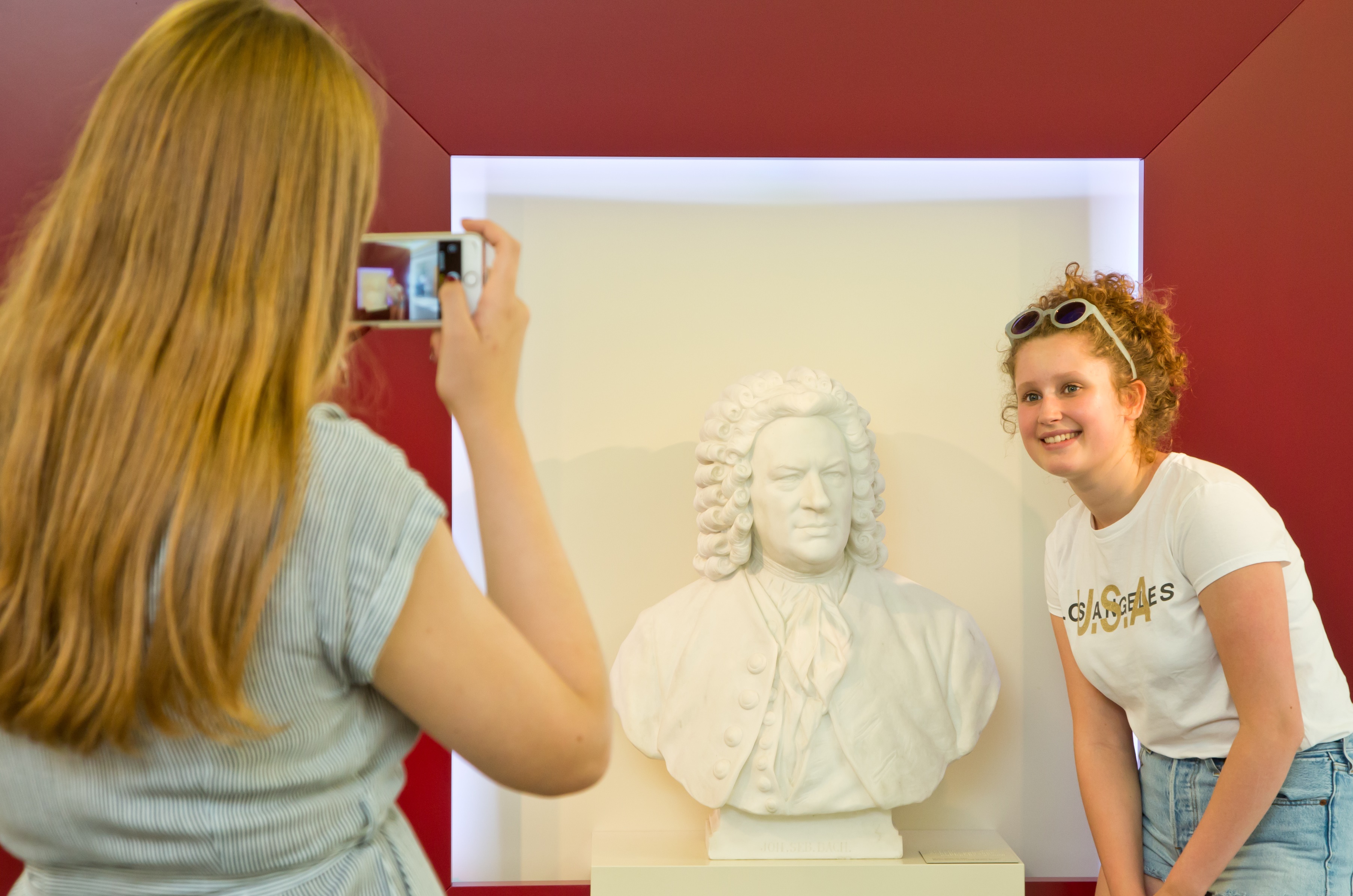
The marble bust in the museum’s foyer is of Johann Sebastian Bach as he looked at about the age of 60. It was created in 1897 by Carl Ludwig Seffner who, along with Max Klinger, was Leipzig’s leading sculptor of the time.
The bust was created as part of a monument project. A new Bach monument in Leipzig had been planned for a long time. The project was given fresh impetus when the probable site of Bach’s grave was rediscovered in St. John’s Cemetery in 1894. Carl Seffner was present when renowned anatomist Wilhelm His identified the bones. Seffner modelled Bach’s face from casts he’d made of the skull and by comparing them to various picture portraits of Bach. He created a number of busts from this model, including the marble one you’re looking at here. His Bach monument which was dedicated in St. Thomas’s Square in 1908 was also based on this model.
Only a few steps from St. Thomas’ Square, in the direction of the main ring road, you’ll find the oldest monument to Johann Sebastian Bach. This was created on the initiative of Gewandhaus capellmeister Felix Mendelssohn Bartholdy, and was unveiled in the presence of Bach’s grandson Wilhelm Friedrich Ernst.
Among the musical dynasties of the Baroque the Bachs assume an exceptional position. For more than 200 years members of this family shaped musical life in central Germany.
The familiy tree in the centre of the exhibition room provides insight in the family of musicians and their compositions. The information about the family tree was passed down to us by Johann Sebastian Bach himself. At the age of 50, he compiled his »Origins of the Musical Bach Family«, a series of short biographical notes on 53 male family members. Almost all of them were musicians – cantors, organists, town and court musicians, or even instrument makers. Only rarely do other professions appear – for example, a carpet-maker or surgeon. The family tree ends with Bach’s sons’ generation because, of course, that was as far as he himself could trace his own family.
There are still descendants of Johann Sebastian Bach alive today. However, the last active composer, Friedrich Wilhelm Ernst, died in 1845. The son of Johann Christoph Friedrich, the socalled Bückeburg Bach, was Johann Sebastian’s only grandson following a musical career. In 1843 and by then an old man, he was the guest of honour at the unveiling ceremony of the first monument to his famous grandfather.
This exhibition room was sponsored by the Ostdeutsche Sparkassenstiftung, Berlin, and the Sparkasse Leipzig.
The centrepiece of this exhibition room is an organ for a very good reason. Bach appreciated no other musical instrument as he did the organ. He composed numerous works for organ, which today still count among the most demanding literature for this instrument, and was considered the most renowned organ virtuoso of his time. A famous organ expert, he also examined organs throughout his life.
The console was part of an instrument made by organ-builder Johann Scheibe. He built it for St. John’s Church in Leipzig, which stood on the cemetery just outside the city centre. In 1743, Bach was invited to inspect the new instrument. From written sources, we know that he tested the new organ and »The trial was perhaps one of the most exacting ever made.« In the end, he gave the organ his complete approval. That is why we know for certain that Bach sat on this organ seat and played this instrument.
The console is only partly original. Parts were replaced or renewed during repair work in the 19th century. It was also badly damaged in the Second World War. At that time, the keys, the music stand, the section on which the stand was secured, and various organ stops were lost. Nevertheless the console is the only preserved section of a Leipzig Bach organ anywhere in the world. Between 2008 and 2010 the console was completely restored for the exhibition in the Bach Museum.
This exhibition room was sponsored by Mrs. Barbara Lambrecht-Schadeberg, Kreuztal.
The restauration of the organ console was sponsored by Mr. Christian Peter Henle, Mülheim (Ruhr).
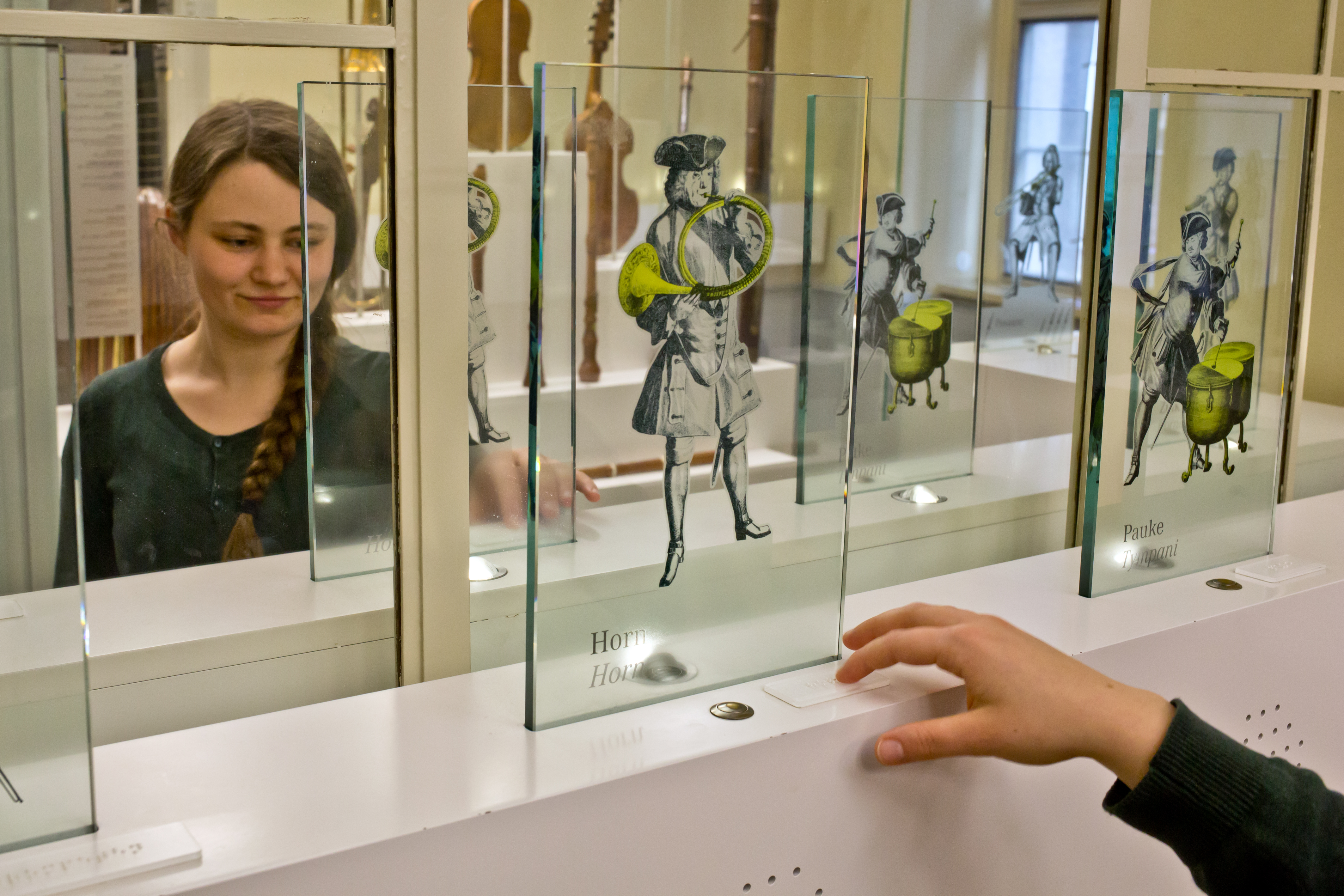
This room is devoted to the world of Baroque instruments. The exhibits are a series of historical musical instruments. Throughout his life, Johann Sebastian Bach was deeply interested in the way instruments worked, and in acoustics and the problems of tuning. He made use of the wide range of tonal possibilities which orchestral instruments offered him, and quickly began to integrate newly developed instruments such as the oboe d’amore, the oboe da caccia or the bassono grosso into his compositions.
Visitors can find out more about how the historical instruments sound from our virtual baroque orchestra on the wall. The »wall orchestra« plays a range of works. The instruments being played in the piece at the moment are marked by a light signal. If you press the corresponding button, the sound of the instrument will be amplified so you can hear it more distinctly. The virtual baroque orchestra plays three pieces: the Gigue from the Orchestral Suite No. 3 in D Major, a section of the Allegro from the Brandenburg Concerto No. 5 and the chorale »Lass dein Engel mit mir fahren« from the cantata »Es erhub sich ein Streit«. The chorale has been arranged for the full orchestra so that visitors can get to know the sound of each individual instrument. Bach himself would never have had an orchestra of this size at his disposal.
The pieces are performed by musicians of the Department for Historical Music at the »Felix Mendelssohn Bartholdy« University of Music and Theatre in Leipzig and conducted by Susanne Scholz.
This exhibition room was sponsored by the Commerzbank-Stiftung, Frankfurt (Main).
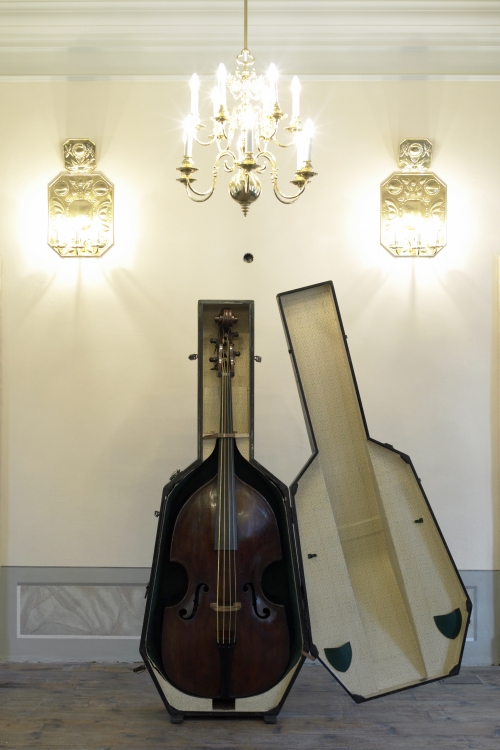
This violone is owned by St. Nicholas’s Church in Leipzig and was built by the Bohemian bass violin-maker Leonardt Pradter in 1672. The churches in Leipzig always kept a basic reserve of musical instruments to be used in the rich musical life of the church. The cantors of St. Thomas’s were also responsible for looking after the instruments in the main churches of St. Thomas’s and St. Nicholas’s, and used them in performances. So we know the instrument on display in the Bach Museum would have been played under Bach’s direction. In his orchestra, the violone was the stringed instrument with the lowest register. As the violone was in continual use until recent times, it has had several changes made to it over the years – with, for example, the neck, pegbox, bridge and scroll all replaced in the 19th century.
The viola d’armore was built by the violin and lute maker Johann Christian Hoffmann (1683-1750) to whom Bach maintained amicable relations. In 1734 he asked him to look after the instruments of St. Thomas’s and St. Nicholas’s. Hoffmann on the other hand mentioned Bach in his will. His »dear friends«, among them Bach, were to distribute among themselves »by lottery« the finished musical instruments in his workshop.
The viola d’amore which combines the range of a violin and a viola has a special lovely and silvery sound. Bach used such an instrument in the St. John Passion.
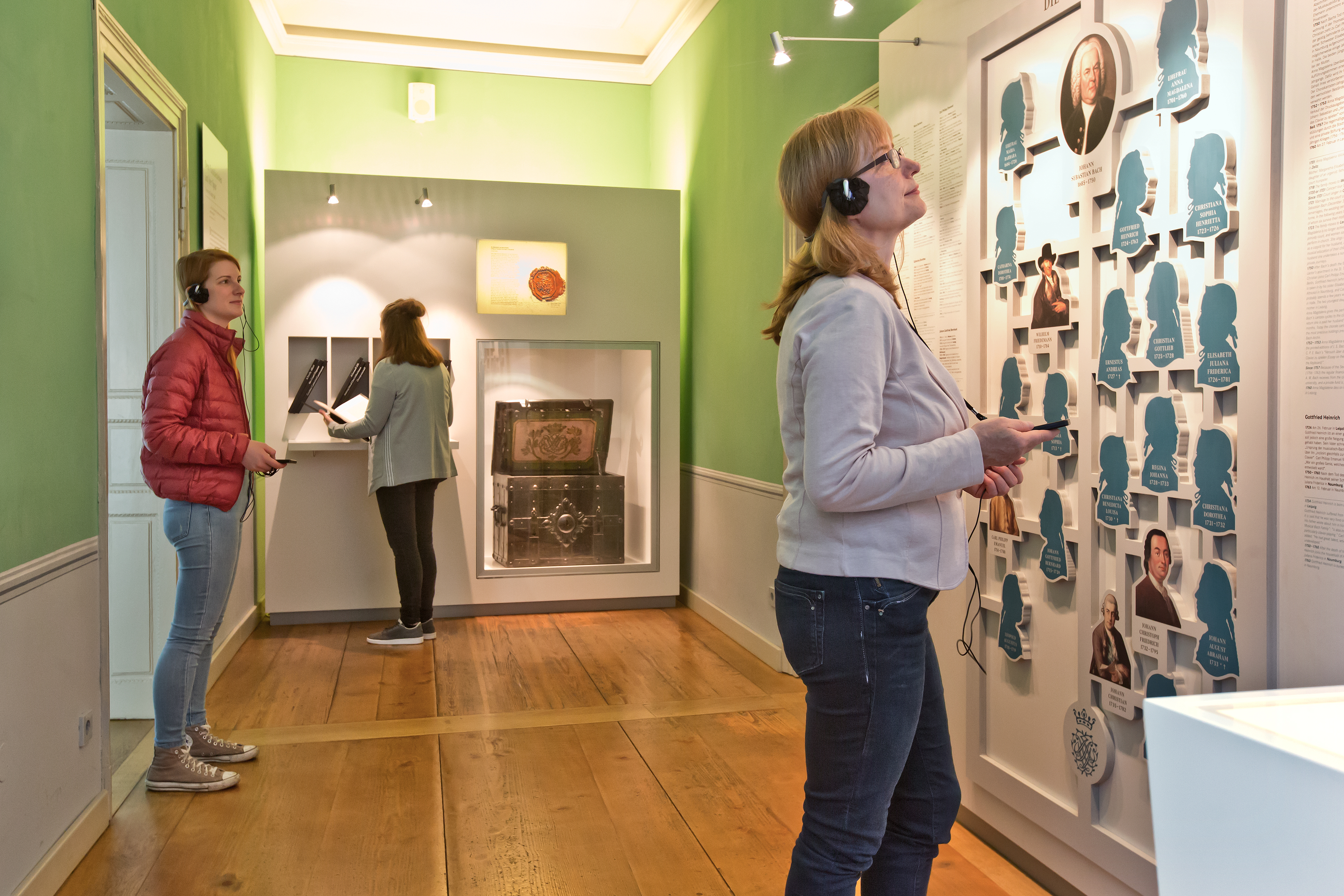
This room is dedicated to the Bachs’ family life and their friendship with their neighbours, the Bose family, who lived at that time in the building which now houses the Bach Museum. From the room’s bay window visitors can look at the place where once the St. Thomas’s School stood, where Bach lived and worked. According to Bach’s son Carl Philipp Emanuel, life at home resembled a »dovecote« in its liveliness. Apart from the parents and their numerous children, there were relatives and private students also living in Bach’s home. Not only that, but the family also had countless guests. A family tree gives an overview of Bach, his wives and children. Nevertheless, we have very little secure evidence about their family life, and what we do know is extremely sparse. Here, we’ve brought together some of the known reliable sources to give us some idea of the private life of the Bach family. This room also displays the only known original piece of furniture from the Bach family home.
This exhibition room was sponsored by the Ostdeutsche Sparkassenstiftung, Berlin, and the Sparkasse Leipzig.
This heavy iron chest is the only piece of furniture known to have come from the Bach family home – though that fact was only discovered in 2009. The chest stood for many years in the Meissen Cathedral Museum, where it was used as a collecting box for donations. It was only when a particularly observant visitor recognised the painted symbols on the inner lid as Bach’s monogram that the full significance of this impressive piece came to light. Johann Sebastian Bach used this monogram as his letter seal from 1722 onwards. The letters JSB appear twice, once from left to right, and once as a mirror image from right to left. The emblem is topped off with a five-pointed crown. The paintwork dates from the first half of the 18th century and is a sure indication that the chest belonged to the Bach family. We don’t know what valuables the Bach family kept in the chest which has a complex locking mechanism with eleven bolts. Perhaps they included the precious medals, silver goods and securities listed as part of Bach’s estate after his death.
The illuminated display panels in this room focus on Bach’s diverse contacts with the royal courts. Bach was employed at court for 15 years. From 1708 to 1717, he was the court organist and concert master in Weimar, and from 1717 to 1723, he was the capellmeister in Köthen. But even before and after these periods, he attached great importance to having good contacts at court. He held the titles of Saxony-Weissenfels capellmeister and Dresden Court Composer. Such titles increased his social standing and were extremely useful when making his concerns known to those in positions of authority. Cultural life in the 18th century was decisively influenced by the courts. Aside from the royal court in Dresden, which set the style trends, Central Germany also had many regional rulers with small courts and palaces, who were well able to afford their own orchestra. Splendour and luxury epitomised life at court, and music was an important factor in their expression.
This exhibition room was sponsored by the Ostdeutsche Sparkassenstiftung, Berlin, and the Sparkasse Leipzig.
When Bach accepted the post of cantor of St. Thomas’s in May 1723, a new chapter of musical history in Leipzig began. For 27 years, he shaped musical life in one of Europe’s main cultural, scientific and economic centres. The cantorate of St. Thomas’s was one of the leading musical positions in Germany, and St. Thomas’s School was one of the most highly sought-after training centres for young musicians. Many of Bach’s most important works were created in Leipzig, including the Passions, the Art of the Fugue and the Mass in B Minor. Bach was responsible for the music in the main churches of St. Nicholas and St. Thomas, and took on a wide range of musical duties, both spiritual and secular. And as well as directing the St. Thomas’s Choir, he also taught a large number of private students.
On the floor, visitors can see a map of the city from 1723, the year Bach moved to Leipzig. The media stations tell about his official duties in the city. Why not take a short walk through Baroque Leipzig? Much of the original street plan and many of the original street names have remained unaltered to this day.
This exhibition room was sponsored by the Ostdeutsche Sparkassenstiftung, Berlin, together with the Sparkasse Leipzig and by Dr. Arend Oetker, Berlin.
In the small Listening Studio, visitors can immerse themselves in Bach’s music. Every single one of his compositions may be called up from the media stations. Listeners can choose from a variety of criteria, such as the title, opening words or the number in Bach’s Work Catalogue – the BWV. Moreover, a chronology gives an overview of when Bach’s most important works were composed.
This exhibition room was sponsored by the Ostdeutsche Sparkassenstiftung, Berlin, together with the Sparkasse Leipzig.
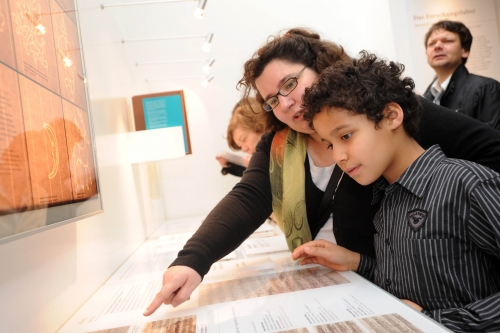
The Leipzig Bach Archive, to which the Bach Museum is attached, is dedicated to research on the lives and works of the widely branching family of musicians. Among many other responsibilities its research fellows make accessible musical sources and documents and prepare musical editions. Between 1954 and 2007 the Göttingen Bach-Institut and the Bach-Archiv Leipzig jointly published the Neue Bach-Ausgabe (complete edition of Bach’s works), which became a model for numerous later editions. In the course of the editorial work refined methods of analyzing paper types and scribal hands led to groundbreaking chronological findings, which resulted in a fundamentally new understanding of Bach and his music. We have learned, for example, that Bach composed nearly all his Leipzig cantatas during his first years as Thomascantor. His workload in this period was enormous.
The Research Laboratory aims to provide insights into the working methods and projects of Bach research. Visitors are invited to try their hand at dating a manuscript or to trace the stages of a critical edition.
The exhibition room was sponsored by the Gerda Henkel Stiftung, Düsseldorf, and by Dr. Werner Minzlaff, Falkensee.
In the Treasure Room, the Bach Museum exhibits its most valuable items. In the display case in the centre, you’ll find its most precious objects – original documents written in Johann Sebastian Bach’s own hand. His manuscripts and many of the other documents, music scores and prints are so fragile that they have to be changed over several times a year. As a result, the items in the Treasure Room are exchanged two or three times a year.
The room was sponsored by the ZEIT-Stiftung Ebelin and Gerd Bucerius, Hamburg.
44 original sets of parts of Bach’s chorale cantata cycle are among the most valuable originals at the Bach Museum. Shortly after Bach took up his position as the cantor of St. Thomas’s, he began an unusually ambitious project. He started composing a new sacral cantata for every Sunday and feast day in the church calendar. Every week, he composed new and elaborate works. But it was not simply a matter of composing the work itself. As soon as Bach had completed the score, the performance materials for the choir and orchestra were written out by copyists, family members, and occasionally Bach himself. Afterwards, Bach had to correct the transcriptions. Finally, the cantatas needed to be rehearsed before they were performed on Sunday either at St. Nicholas’s or St. Thomas’s. There is always one complete set of parts on display in the Bach Museum. The items are exchanged two or three times a year.
In the treasure room, there’s a small glass casket with finds from what’s thought to be the graves of Johann Sebastian Bach and his wife Anna Magdalena. They were both buried in St. John’s Cemetery in Leipzig. Over the next 100 years, the exact location of the graves was slowly forgotten. In 1894, a commission was finally set up to establish the location of the graves. Thanks to oral traditions and other evidence, two graves were identified as those of Bach and his wife.
The small objects in the glass casket come from these two graves. You can see two splinters from an oak coffin and a clasp which probably secured the belt of a burial shroud. The thimble in the casket is also thought to have been in Anna Magdalena’s grave. The small objects were almost treated like relics. For the next century or so, the glass casket was first kept in St. John’s parish and then in St. Nicholas’s Church. Since 2010 it has been on permanent loan in the Bach Museum.
The painted wooden panels depict weapons, items of armour, drums and other military equipment. This large painting dates from the first half of the 18th century. It’s one of several surprise finds discovered behind a wall between two offices when the museum was being renovated in 2008. The individual panels have only survived because they were taken as filling material.
The panels were once the four doors of a built-in cabinet, which was probably their »armory« - the place where the Bose family stored their collection of weapons and military memorabilia. The piece on display gives an interesting insight into the world of the Bose family, who was befriended with the Bach family.
These remnants of historic wallpaper came to light during renovation work in the Bach Museum in 2008. They evidence the sophisticated lifestyle of the former occupants. Several layers had been papered over each other. The luxurious rose-tendril wallpaper was one of the most fashionable decorative patterns of its kind at trade fairs in around 1800. The marble-patterned papers under it were probably produced by a local manufacturer in around 1780. Similar papers can be seen for example in the Gohliser Schlösschen in Leipzig where the Bach Archive was located for many years.
The little museum garden resembles the pleasure garden which the Bose family, Bach’s neighbours, had laid out in the same place in the early 18th century. This kind of »house garden« was an extravagant luxury in those days. The densely built city centre generally didn’t normally allow such precious space to be used in this way. The Boses’ pleasure garden was about 32 metres long and 18 metres wide, making it slightly larger than our small rose garden. The Boses planted baroque decorative flowerbeds and fruit trees and had a small summer house built. The landscaped flowerbeds and borders were framed by boxwood. In the middle of the garden, there was a stone fountain. On the left, next to the entrance, there was a separate small yard for chickens and other livestock. Quite possibly, Johann Sebastian Bach and his family often spent time in this garden when they visited their neighbours.